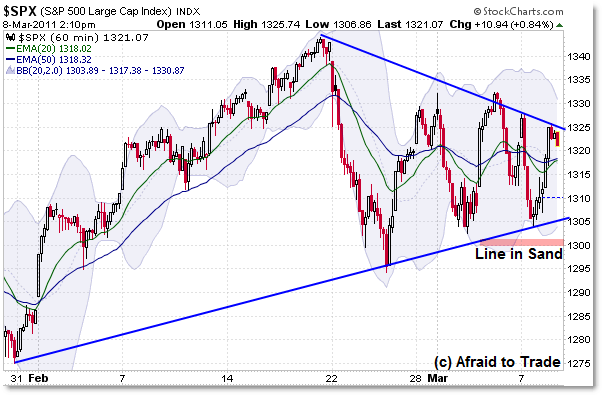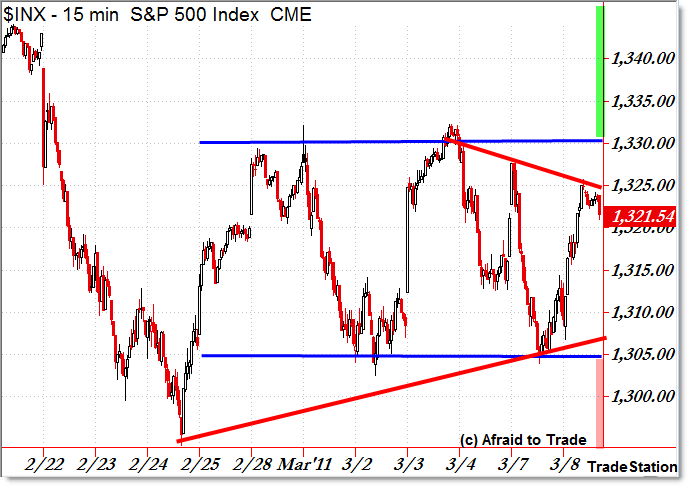The Current Contracting Consolidation in the SP500
On a short-term basis, the S&P 500 is contracting into a clean trading range between well-defined triangle or trendline boundaries you should know.
Let’s take a look at two charts that show this range and the levels traders are watching closely:

First, let’s look at the bigger 60-min picture which shows a clean symmetrical triangle forming in the index.
The upper line comes in at today’s (so far) high of 1,325 while the lower rising support line rests at the 1,305 level.
It would be safe to raise these levels to 1,300 for support and 1,330 for resistance to make it easier to remember as you trade intraday – and there have been some great intraday reversal plays as the market tested these boundaries (in terms of divergences and reversal signals at the boundary levels).
The horizontal “midpoint” or fair value line appears at the 1,317 (not drawn) level which is roughly where the moving averages reside.
Take a look at the left side of the chart to see how effective moving averages are for setting up short-term trade entries (on bounces to the EMAs) and then how useless these same EMAs are in the context of a Trading Range.
The Range Alternation Principle – that the market alternates between trend and range – teaches us to favor certain indicators in trending environments (like moving averages) and then ignore them (favor other indicators like Bollinger Bands) in range contraction/consolidation environments.
Anyway – the chart above displays that lesson well.
Let’s drop down closer and see the 15-min range boundaries and the tiny trendlines that are coming into play:

Depending on your perspective, you’re either viewing this as a sideways rectangle (blue) with boundaries at 1,330 and 1,305… or you’re viewing it as the broader triangle I showed on the hourly chart with similar levels.
It doesn’t matter what you call it, only that you view it as a sideways contraction or consolidation with trendlines that contain intraday price highs and lows.
These boundaries won’t hold forever, and the next play will be a breakout move when it occurs, and it will be best to wait for the market to tip its hand in a breakout with confirming volume and internals instead of trying to outsmart the market with a prediction or pre-play on which direction price will break.
The broader picture shows that the bulls get into serious chart trouble under 1,300 and the bears – not surprisingly – get into serious chart trouble with a break to new highs above 1,350.
Those are the intermediate levels to watch for a bigger picture play, while the smaller picture is playing out in the Bull/Bear battle between the current intraday reference levels.
Watch and trade closely!
Corey Rosenbloom, CMT
Afraid to Trade.com
Follow Corey on Twitter: http://twitter.com/afraidtotrade
Corey’s new book The Complete Trading Course (Wiley Finance) is now available!

Great stuff Corey. Love the book.
Hey Corey
I've got that same triangle drawn… but I've got it on a 30-min ES chart including overnight trading. Done that way the upper boundary comes out a little differently – showing we didn't reach the upper resistance Tuesday. I was expecting today to turn into a trend day and come close to the ES upper limit – but no go.
Just thought I'd mention it in case you hadn't looked at it. Since price seemed to stop at the SPX triangle limit maybe we give preference to that version?
Any credence to this? Indicators bullish for a move forward after two 10 day consolidation periods.
http://www.screencast.com/user…